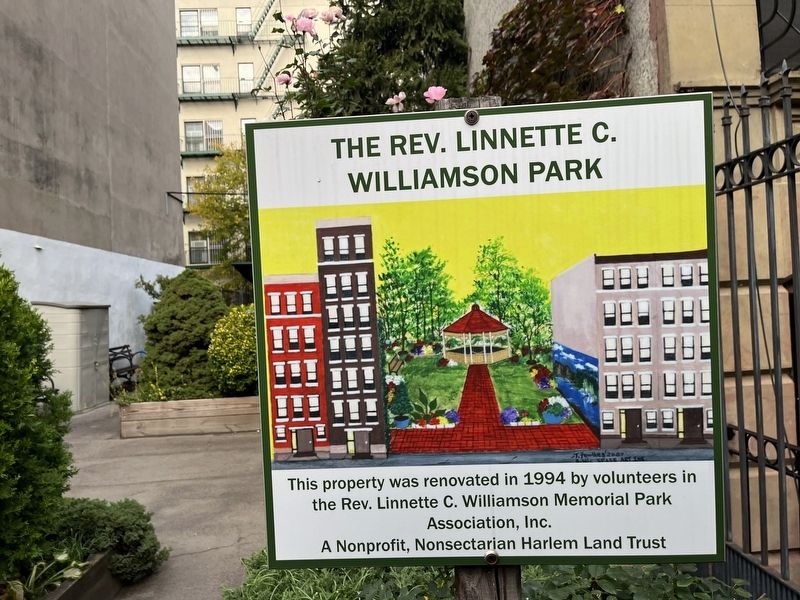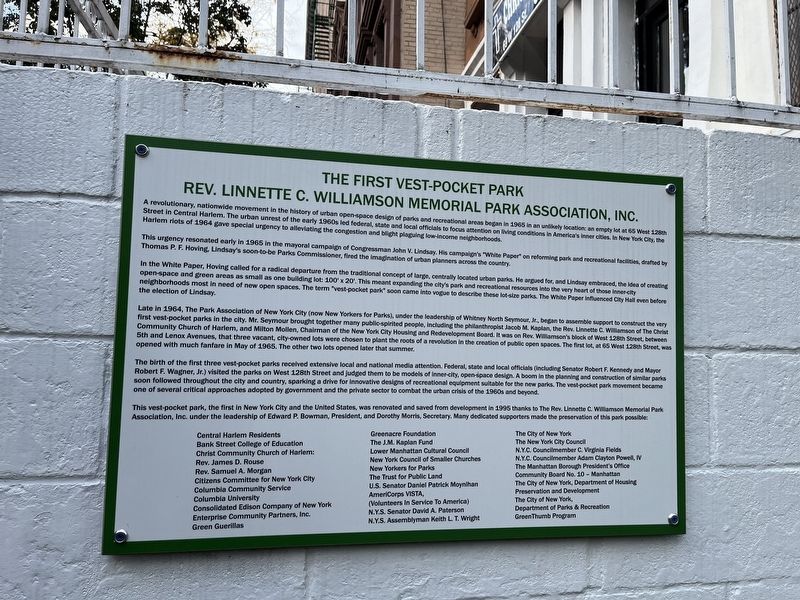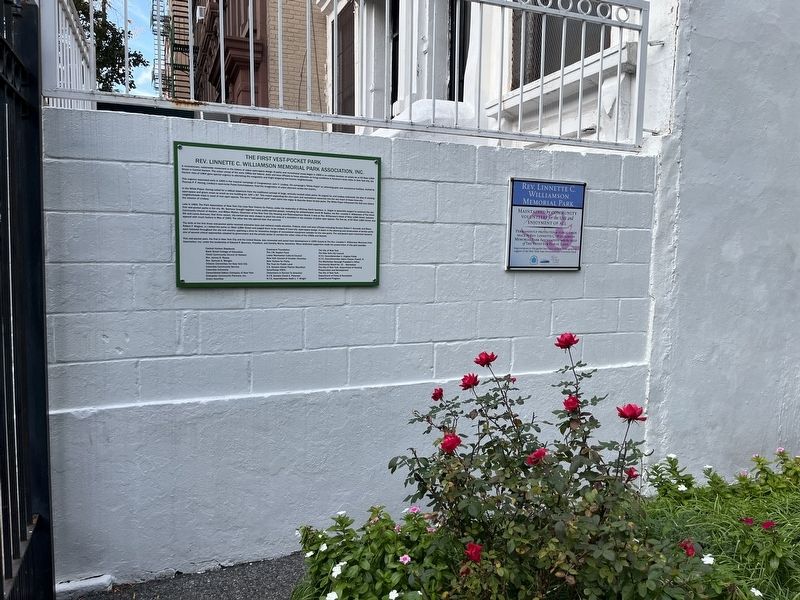Central Harlem in Manhattan in New York County, New York — The American Northeast (Mid-Atlantic)
The First Vest-Pocket Park
Rev. Linnette C. Williamson Memorial Park Association, Inc.
A revolutionary, nationwide movement in the history of urban open-space design of parks and recreational areas began in 1965 in an unlikely location: an empty lot at 65 West 128th Street in Central Harlem. The urban unrest of the early 1960s led federal, state and local officials to focus attention on living conditions in America's inner cities. In New York City, the Harlem riots of 1964 gave special urgency to alleviating the congestion and blight plaguing low-income neighborhoods.
This urgency resonated early in 1965 in the mayoral campaign of Congressman John V. Lindsay. His campaign's "White Paper" on reforming park and recreational facilities, drafted by Thomas P.F. Hoving, Lindsay's soon-to-be Parks Commissioner, fired the imagination of urban planners across the country.
In the White Paper, Hoving called for a radical departure from the traditional concept of large, centrally located urban parks. He argued for, and Lindsay embraced, the idea of creating open-space and green areas as small as one building lot: 100' x 20'. This meant expanding the city's park and recreational resources into the very heart of those inner-city neighborhoods most in need of new open spaces. The term "vest-pocket park" soon came into vogue to describe these lot-size parks. The White Paper influenced City Hall even before the election of Lindsay.
Late in 1964, The Park Association of New York City (now New Yorkers for Parks), under the leadership of Whitney North Seymour, Jr., began to assemble support to construct the very first vest-pocket parks in the city. Mr. Seymour brought together many public-spirited people, including the philanthropist Jacob M. Kaplan, the Rev. Linnette C. Williamson of The Christ Community Church of Harlem, and Milton Mollen, Chairman of the New York City Housing and Redevelopment Board. It was on Rev. Williamson's block of West 128th Street, between 5th and Lenox Avenues, that three vacant, city-owned lots were chosen to plant the roots of a revolution in the creation of public open spaces. The first lot, at 65 West 128th Street, was opened with much fanfare in May of 1965. The other two lots opened later that summer.
The birth of the first three vest-pocket parks received extensive local and national media attention. Federal, state and local officials (including Senator Robert F. Kennedy and Mayor Robert F. Wagner, Jr.) visited the parks on West 128th Street and judged them to be models of inner-city, open space design. A boom in the planning and construction of similar parks soon followed throughout the city and country, sparking a drive for innovative designs of recreational equipment suitable for new parks. The vest-pocket park movement became one
This vest-pocket park, the first in New York City and the United States, was renovated and saved from development in 1995 thanks to The Rev. Linnette C. Williamson Memorial Park Association, Inc. under the leadership of Edward P. Bowman, President, and Dorothy Morris, Secretary. Many dedicated supporters made the preservation of this park possible.
Erected by Rev. Linnette C. Williamson Memorial Park Association, Inc.
Topics. This historical marker is listed in these topic lists: Charity & Public Work • Parks & Recreational Areas. A significant historical month for this entry is May 1965.
Location. 40° 48.562′ N, 73° 56.583′ W. Marker is in Manhattan, New York, in New York County. It is in Central Harlem. Marker is on West 128th Street just east of Malcolm X Boulevard/Lenox Avenue when traveling west. Touch for map. Marker is at or near this postal address: 69 W 128th St, New York NY 10027, United States of America. Touch for directions.
Other nearby markers. At least 8 other markers are within walking distance of this marker. Zora Neale Hurston (approx. 0.2 miles away); Langston Hughes House (approx. 0.2 miles away); Romare H. Bearden (approx. ¼ mile away); Scott Joplin (approx. ¼ mile away); The New York Age

Photographed By Devry Becker Jones (CC0), November 5, 2022
3. Sign at the entrance of The Rev. Linnette C. Williamson Park
Credits. This page was last revised on January 31, 2023. It was originally submitted on November 10, 2022, by Devry Becker Jones of Washington, District of Columbia. This page has been viewed 138 times since then and 45 times this year. Photos: 1, 2, 3. submitted on November 10, 2022, by Devry Becker Jones of Washington, District of Columbia.

